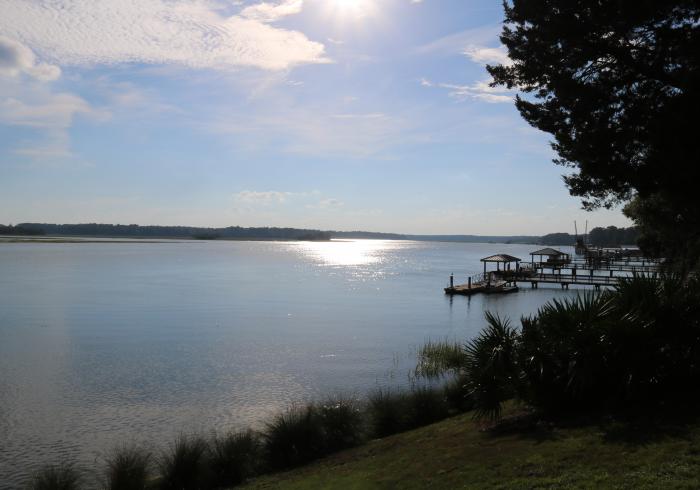Bacteria Overtaking the May River
https://www.visitbluffton.org/see-do/may-river
The May River has experienced a decrease in water quality over the last 25 years.
March 24, 2022
BLUFFTON, S.C. — The May River has been a part of my life ever since I learned to swim. But recently, I’ve learned, the water quality of the May River has begun to deteriorate due to high amounts of fecal coliform bacteria concentration.
According to the S.C. Department of Health and Environmental Control’s shellfish database, the increase of fecal coliform bacteria concentration has been happening since the mid- to late 1990’s as Bluffton’s population has grown and this has led to development of more businesses and homes along the May River. This growth and development has had the biggest impact on the harvesting of shellfish in Bluffton.
Many people and businesses in Bluffton harvest shellfish from the May River. It is very popular in the area as there are townwide oyster roasts held at the Bluffton Oyster Company. Given the importance of shellfish and the river, the leaders of Bluffton should take action by putting into place policies to stop stormwater runoff and decrease the salinity of the water. They should do this because of the multiple ways the river is economically important, and because it’s a major part of the community’s quality of life.
One of the reasons the bacteria has made its way into the river is sewage spills. For example, in October of 2020, 105,000 gallons of septic waste leaked into the May River. According to a report from the Beaufort-Jasper Water and Sewer Authority, a manhole that covered a sanitary sewer overflowed and the waste found its way to a drainage ditch that led to the river.
Not only did the spill increase the concentration of bacteria in the river but it closed down the harvesting of shellfish for 21 days, according to the The (Hilton Head, S.C.) Island Packet. The people and businesses that make a living off of harvesting shellfish had to find new areas to fish to keep up with demand for those three weeks, according to Bluffton Town Councilor Larry Toomer, who also told the paper, “I wasn’t satisfied with the response time.”
This incident woke the town up about the danger to the river, but almost a year to the day before disaster struck, The Island Packet had tried to alert the public to the issue. In a story headlined “Bacteria up 3,150% in Bluffton’s May River in 20 years. How did we get here?” reporter Kim Bayless wrote, “A little more than a decade ago, the former director of National Oceanic and Atmospheric Administration’s Marine Laboratory gave a grim warning to Bluffton’s leaders: If the town’s rate of building and development continued, it would seriously damage local waters and hurt shellfishing in the May River.”
Bayless’s story quoted a University of South Carolina-Beaufort study that found that fecal coliform bacteria levels have been rising in the May River for the past two decades and, in some parts, are above what is considered safe for shellfish harvesting. The study also showed that the increase in population led to more storm runoff. Because of development, there is not enough grass to absorb the runoff, and it ends up in the May River. The added water lowers the salinity of the water, which allows the bacteria to thrive.
Not only do the fecal coliform bacteria thrive in the lower salinity but so do other diseases and bacterias, putting all marine life in the May River at higher risk.
As I investigated this issue, I discovered that The Town of Bluffton has had a May River Watershed Action Plan in place for ten years—it was passed in November 2011. In order to protect the river from further deterioration and help to restore the shellfish population, the plan allows for people to buy land or property to begin conservation projects to help the river’s ecosystem. It also establishes areas in the river that can and cannot be harvested due to the natural resources present. Most importantly, it protects vulnerable areas of the river from development and gives the town government the power to approve and disapprove buildings near the river.
You would think with this plan in place the river can be protected and kept from deteriorating, right? This would be the case if the town leaders enforced the plan. Instead, as I’ve been saying, the town of Bluffton continues to be developed without regard to the health of the river.
This river has been a part of the lives of the people of Bluffton ever since they have called the city home. It is a source of food and a source of family fun on the weekends. If the town leaders and the citizens do not come together to protect this body of water, then who knows in the future whether or not the river will even be usable?
In my opinion, the town leaders of Bluffton are not leaving enough land surrounding the river undeveloped. Instead of following the laws that they have already put into place and the plan they have already approved, they are continuing to overdevelop Bluffton. If this continues, the May River will be unable to provide the people of Bluffton with resources.
The citizens of Bluffton have to speak up and demand action from their leaders. I believe that if the May River Watershed Action Plan were followed and enforced that the levels of fecal coliform bacteria concentration will begin to decrease and the people and businesses who rely on the May River will flourish once again.





